My Quinoa Tabouli is a gluten-free spin on a classic Middle Eastern dish.

I have adapted this popular dish to a Gluten-Free Tabouli, to suit people with dietary requirements, or those looking to cut down their carb intake.
Wikipedia advises that Tabouli is originally from the mountains between Syria and Lebanon.
It is a staple in Lebanese homes and is one of the most popular salads throughout the Middle East. As with Hummus, Baba Ganoush and Falafel, Tabouli is now popular throughout the world.
Tabouli, also known as tabbouleh, is traditionally made using bulgur wheat. I have converted the recipe to a gluten-free version by using quinoa (pronounced keen-wah) instead.
The inclusion of quinoa also gives the salad a boost of protein. This makes it a healthy choice for vegetarians or those who follow a plant-based diet.
This is a vibrant, fresh-tasting, healthy salad which is easily made. The green in tabouli is mostly provided by fresh parsley. However, fresh mint and spring onions/scallions are also included, and some cherry tomatoes add colour to the dish. Finally, a simple dressing of extra virgin olive oil and fresh lemon juice heightens and brightens the flavours.
Tabouli is not just delicious to eat; this is also an extremely healthy, nutritious dish. The fresh herbs, spring onions/scallions and tomatoes contain generous amounts of vitamins, minerals and dietary fibre. The quinoa contributes protein.
As with so many delicious foods, it is the balance of flavours that makes a dish successful. This is the case, too, with tabouli. I prefer my tabouli with a lot of parsley and the vibrant tang of lemon.
You can serve this as a nutritious side dish, part of a meze or as a stand-alone, light meal.
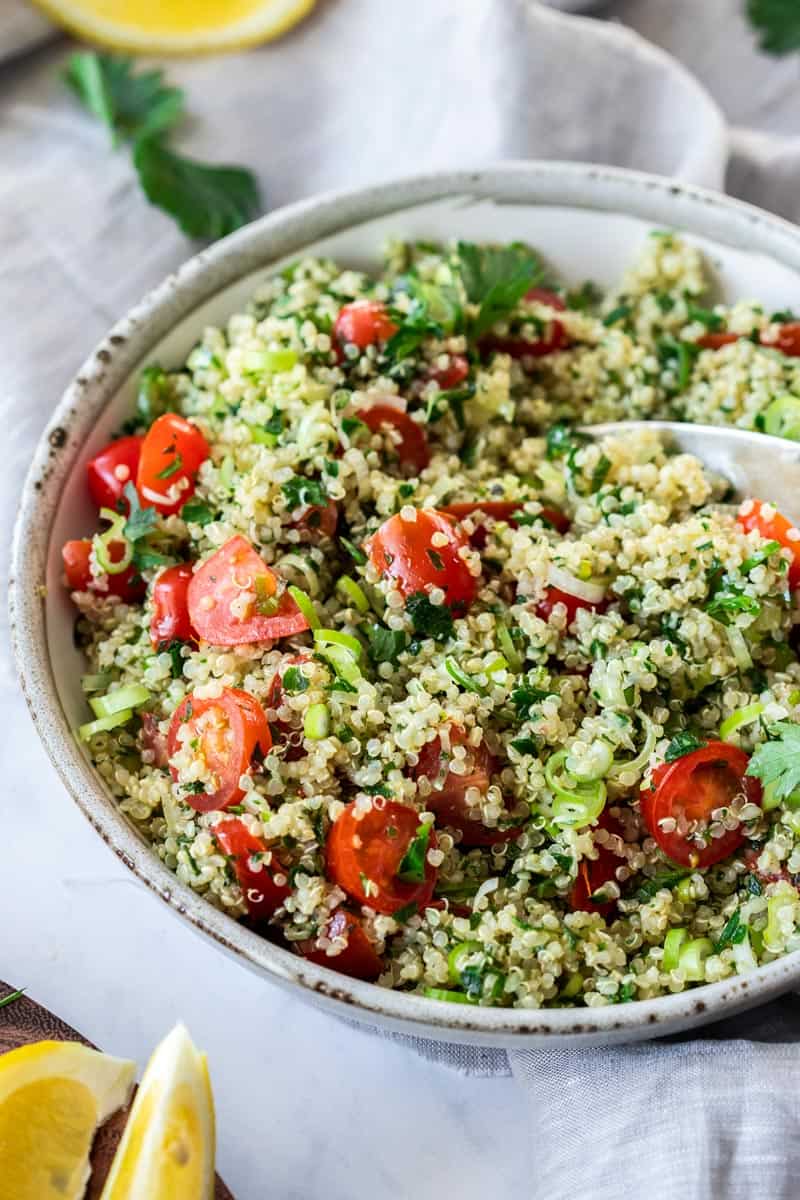
I use these ingredients in my Quinoa Tabouli:
Quinoa:
For this recipe, I have used a mixture of quinoa which contains three colours. However, you could use just one variety. The white quinoa is the one most often used.
Flat Leaf/Continental Parsley:
I prefer the flavour and texture of flat leaf/continental parsley. However, you could use the curly leaf variety if you prefer.
Fresh Mint:
Fresh mint adds a vibrant burst of flavour to sweet and savoury dishes. Please do not be tempted to use the dried herb.
Spring Onions/Scallions/Green Onions:
This is the same ingredient, known by different names. They are members of the onion family but have a much milder flavour, making them ideal to use in salads.
Cherry Tomatoes:
My preference is for cherry tomatoes as I find them to generally be sweeter than larger ones. However, if you grow your own tomatoes or have a reliable source it's perfectly fine to use larger ones. I would then recommend that you remove the seeds before using to get rid of excess tomato juices.
Lemon Juice:
Please use fresh lemon juice; the flavour is much fresher and brighter than the bottled variety. The salad should have a lemony tang.
Olive Oil:
I have used Extra Virgin Olive Oil; it has superior flavour along with a number of nutritional benefits.
Sea Salt and Freshly Ground Black Pepper:
Add these ingredients to your taste. I highly recommend good quality sea salt flakes and freshly ground pepper for maximum flavour.

What is Quinoa?
Quinoa is something of a culinary superstar. It is currently one of the most popular health foods. Highly nutritious, it is a complete protein, ideal for vegetarians and vegans as it contains all the amino acids and many vitamins and minerals.
Quinoa is an ancient crop, originally from the Andes, and is the seed of a plant which is related to Swiss chard, beets and spinach. It has been grown in South America for thousands of years.
It has the versatility of rice and can be used in sweet or savoury dishes. Serve quinoa with a stir-fry, use risotto-style or in a myriad of variations in salads.
I have used Quinoa in this dish to create a Gluten-Free Tabouli.
Quinoa comes in three different colours. The most popular is white but there is also red and black.
There are slight flavour differences.
White Quinoa - this has the most delicate flavour. It is the most tender and cooks the fastest. In addition, it will be fluffier than the other varieties.
Red Quinoa - this is slightly nuttier than the white variety and has a slightly chewier texture.
Black Quinoa - this variety is slightly sweeter and a little earthier than the white. It has a crunchy texture and may take a little longer to cook.
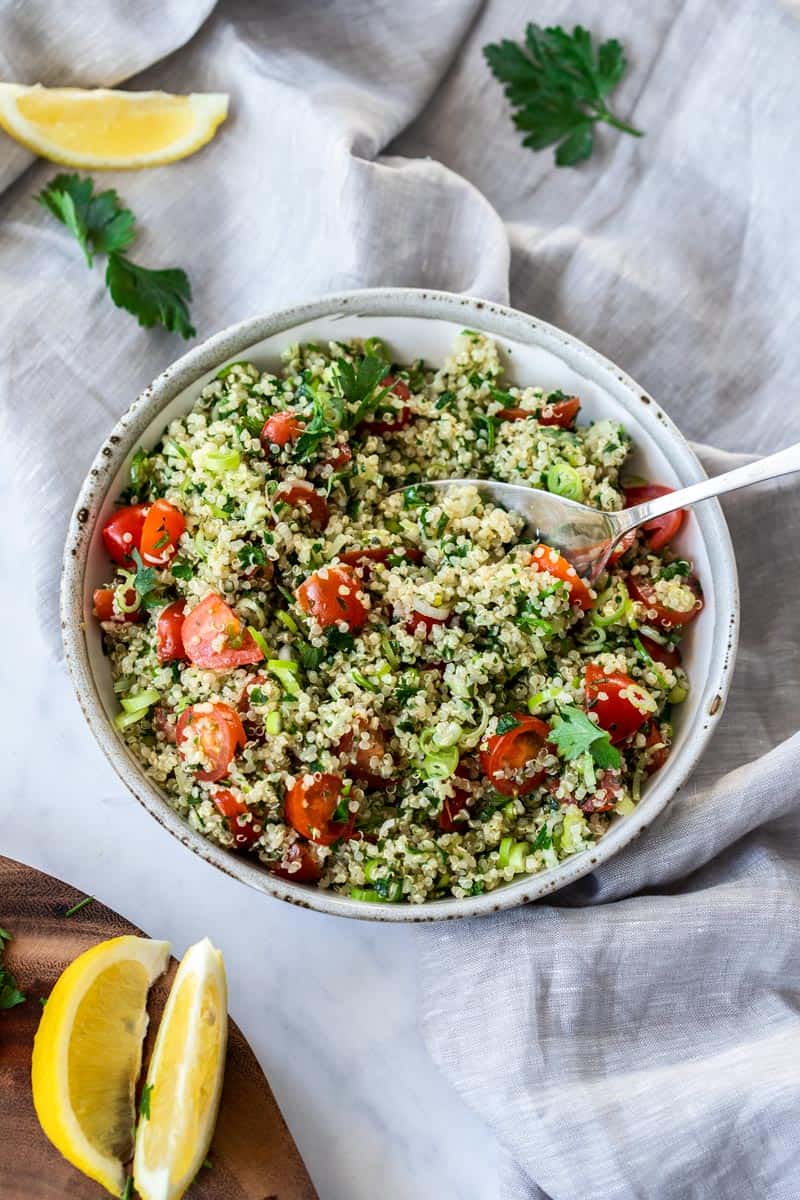
This is how I make the Quinoa Tabouli:
To begin, I rinse the quinoa to remove an outer coating, called saponin. It is a naturally occurring chemical which deters insects. It does, however, have a bitter flavour so it is important to vigorously rinse the quinoa before cooking.
The quinoa is cooked by the absorption method, similar to a method used for cooking rice.
I add the well-drained quinoa to a saucepan and add double the amount of water. I bring it to the boil, then simmer, covered for 8-10 minutes until the liquid is absorbed and the seeds are cooked.
This is an approximate cooking time. The actual time will vary depending on the variety or the age of the quinoa. I check a few minutes before the suggested cooking time so that I don't overcook the quinoa.
You will be able to see when the quinoa is cooked. You will notice that the seeds have little curly "tails".
When the quinoa is cooked, I remove the saucepan from the heat and place 3 layers of kitchen paper or a clean tea towel over the pan. I cover it with the lid and set it aside for 5 minutes. The kitchen paper/tea towel will absorb any excess moisture.
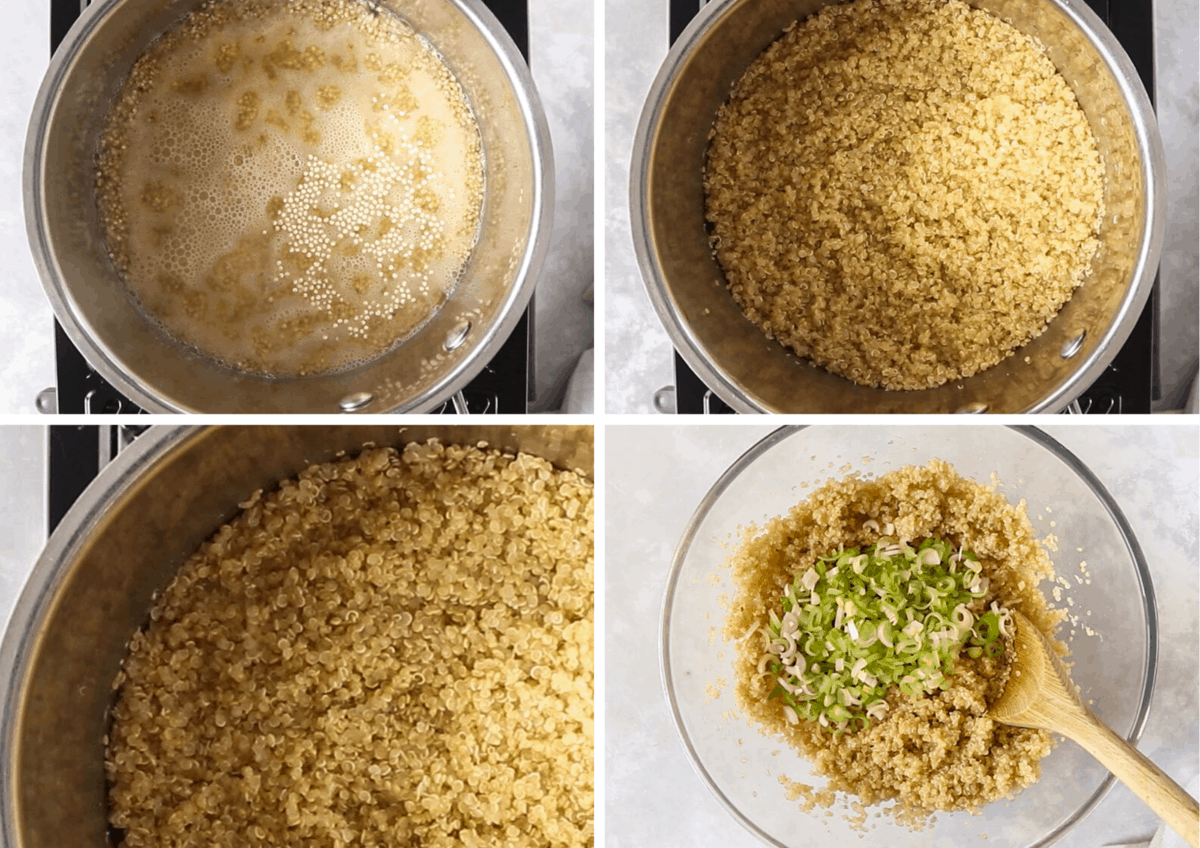
I fluff the cooked quinoa lightly with a fork then place it into a bowl and allow it to completely cool. Finally, I add the remaining ingredients, toss them gently together and adjust the seasoning if necessary. It should have a bright, lemony tang.
The Gluten-Free Tabouli keeps well for a few days in the fridge. In fact, the flavours develop a little more over time.
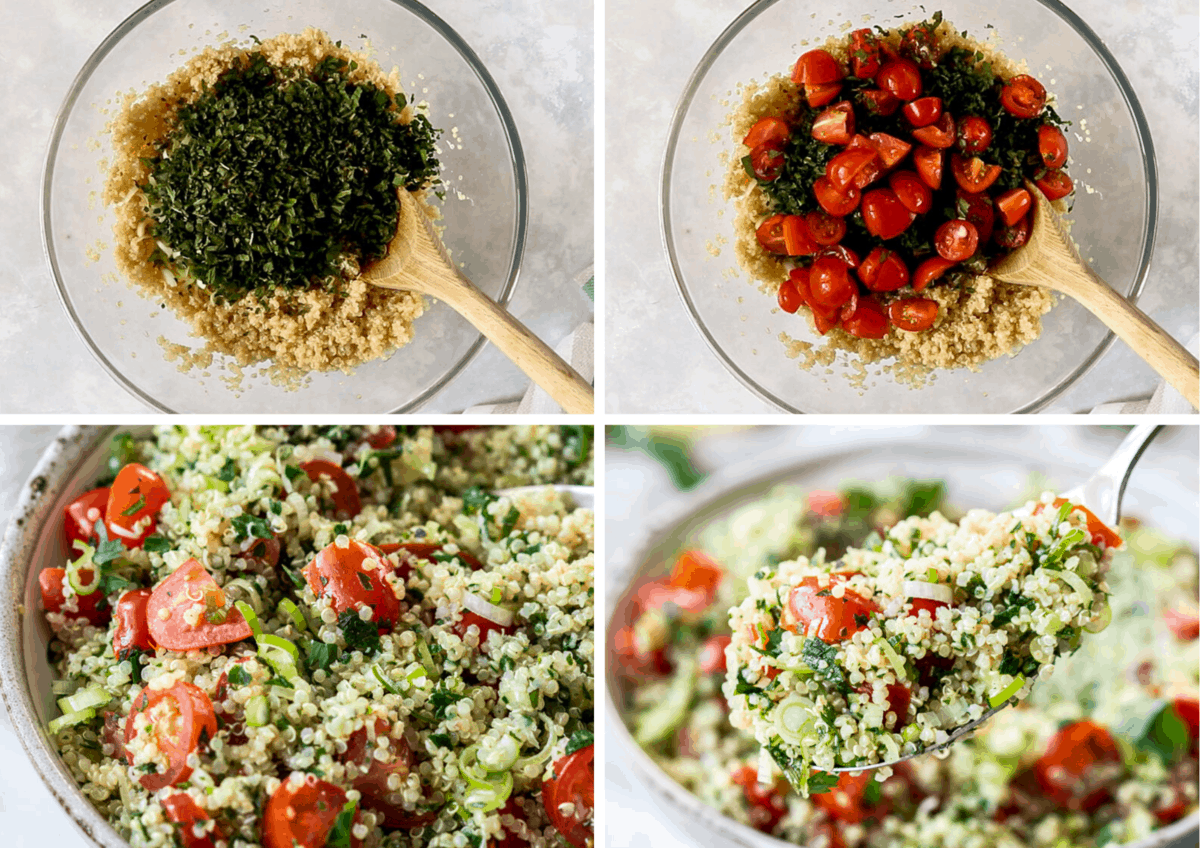
Tips for success:
For the best flavour, you need to find the freshest flat-leaf/continental parsley that you can find.
Despite the temptation, do not use a food processor to chop the herbs. The processor will bruise the leaves. Instead, you will need a very sharp knife. Gather the herbs together, hold them firmly with one hand and with the other hand, very finely slice them.
You can use a small amount of the parsley stalk but should only use the mint leaves.
Using ripe, but firm tomatoes is essential. I like to use cherry tomatoes as they are generally sweeter. However, you can use large tomatoes. If using large tomatoes, I prefer to remove and discard the seeds. Too much of the tomato juice will make the salad soggy. Alternatively, you can dice the tomatoes ahead of time and drain the excess juice.
When it comes to making tabouli, there are regional variations. Lebanese tabouli traditionally has parsley as the star ingredient; however, ratios vary throughout the Middle East. Customise the ratio of ingredients to suit your personal taste.
For the best flavour, always use freshly squeezed lemon juice. The tabouli should have a bright, lemony tang.
My choice is extra virgin olive oil. It is the best olive oil available, being extracted naturally by the ancient method of pressing the olives. It, therefore, retains the flavour and nutrients of the olive fruit.
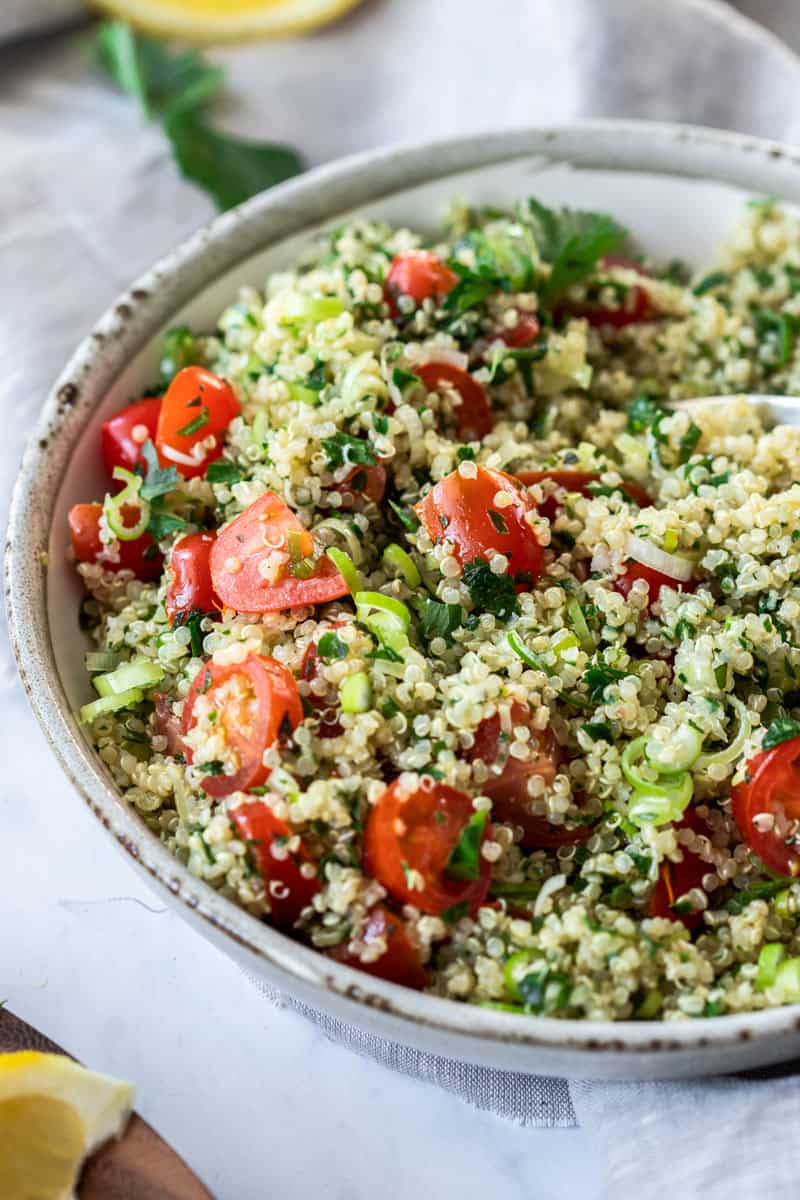
When it comes to serving my Quinoa Tabouli:
There are a number of ways in which to enjoy tabouli. Firstly, it is perfect as part of a meze. Spread it onto a large, shallow platter. You could serve it with pita bread, hummus, baba ganoush, olives and falafel.
In addition, it is also traditionally served in small lettuce cups as an appetiser.
Alternatively, serve it as a side dish. It is an ideal accompaniment to grilled meats, poultry or fish.
Serve it as a light, nutritious main meal. Add some chickpeas or feta to the tabouli. Whilst not traditional, they work well together and add a boost of protein. Alternatively, if you have some leftover roast chicken top the tabouli with a few strips.
Use the sunny, bright flavours of parsley, spring onions, tomato, lemon and mint to create the salad that is just right for you. To achieve your preferred style, just taste as you go. Not only is this salad fresh and bright, it has great texture.
You can make the tabouli one day ahead as the flavours will develop even further. Cover and refrigerate.
To add another layer of protein, top the tabouli with feta cheese or add a few chickpeas.
Delicious!

Love quinoa as much as we do? Be sure to also try:
And if you're looking for other great vegan salads, try:
- Sweet and Sour Carrot Salad
- Marinated Tomato Salad
- Orange, Spinach and Pomegranate Salad
- Charred Corn and Black Bean Salad
- Pumpkin, Cranberry and Almond Salad
Please let me know in the comments below if you try my Gluten-Free and Vegan Quinoa Tabouli.
Alex xx
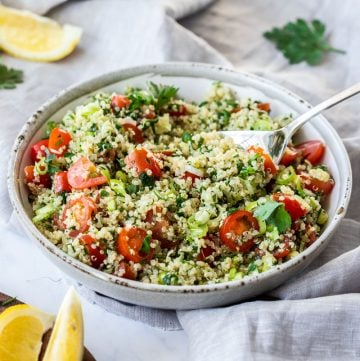
Quinoa Tabouli
with specific dietary requirements as it is gluten-free, dairy-free and vegan.
Please note:
For accuracy, when weights are provided, we recommend weighing your ingredients. This will produce the best results. All oven temperatures listed are for fan forced.
Ingredients
- 1 cup quinoa, rinsed well See Note 1
- 2 cups water
- 2 cups flat-leaf parsley loosely packed, very finely sliced See Note 2
- ½ cup fresh mint leaves, finely sliced See Note 3
- 3 spring onions/scallions, finely sliced See Note 4
- 250 gm cherry tomatoes, quartered See Note 5
- 2 tablespoon freshly squeezed lemon juice (or to taste) See Note 6
- ½ cup extra virgin olive oil See Note 7
- sea salt and freshly ground black pepper, to taste
Instructions
- Put the quinoa in a fine-meshed sieve and rinse well under cold, running water, swishing the quinoa with your hand. Drain the quinoa well.
- Add 2 cups of water to a medium-size saucepan. Add the quinoa. Over medium-high heat bring it to a boil. Lower the heat and simmer, covered for about 10 minutes, until the seeds are tender. When they are cooked you will notice that they have little curly "tails".
- Remove the saucepan from the heat. Place a clean tea towel or 3 layers of paper towel over the saucepan. Put the lid back on and set aside for 5 minutes. The tea towel/paper towel will absorb excess moisture.
- Fluff the quinoa with a fork, then turn it into a bowl and leave to cool completely.
- Add the finely sliced parsley, mint, spring onions/scallions and quartered tomatoes to the quinoa.
- Add the olive oil and lemon juice, sea salt and freshly ground black pepper and gently toss the ingredients together.
- Taste and adjust the seasoning if necessary, adding more olive oil, lemon juice, salt and pepper as required. The salad should have a bright, lemony flavour but adjust it to your personal taste.
- Serve at room temperature or refrigerate and serve cold.
Video
Notes
- It is important to thoroughly rinse the quinoa. The outside of the quinoa has a naturally occurring chemical, called saponin, which deters insects. It has a bitter taste and rinsing well helps to remove this coating. After rinsing, it is essential to thoroughly drain the quinoa. After draining, I place the sieve on a few layers of kitchen paper to absorb excess moisture.
- Do not use a food processor to chop the parsley, the processor will bruise the leaves. Instead, you will need a very sharp knife. Gather the parsley leaves together, hold them firmly with one hand and with the other hand, very finely slice them. You can use a small amount of the parsley stalk.
Use more parsley if you wish. There are regional variations for this salad, and some have parsley as the starring ingredient. It is a matter of taste. - The mint should also be chopped by hand, as in the note above. You should use only the leaves of the mint.
- I used the white and green part of the spring onions. Just remove the root.
- I use cherry tomatoes are they generally have a sweeter flavour. However, if you have large tomatoes that you would like to use this is fine. Either remove the seeds and use just the flesh or chop the whole tomatoes and drain them well before adding to the quinoa. Excess tomato juice will make the salad soggy.
- Lemon juice is a key flavouring ingredient in this recipe. As such, it is essential that the juice be freshly squeezed.
- I prefer extra virgin olive oil for its superior flavour and health-benefiting nutrients.
Nutrition Estimate:
Nutritional Disclaimer:
The nutritional information is an estimate only, and is derived from online calculators. For accurate results, we recommend calculating the nutritional information based on the ingredients and brands you use.
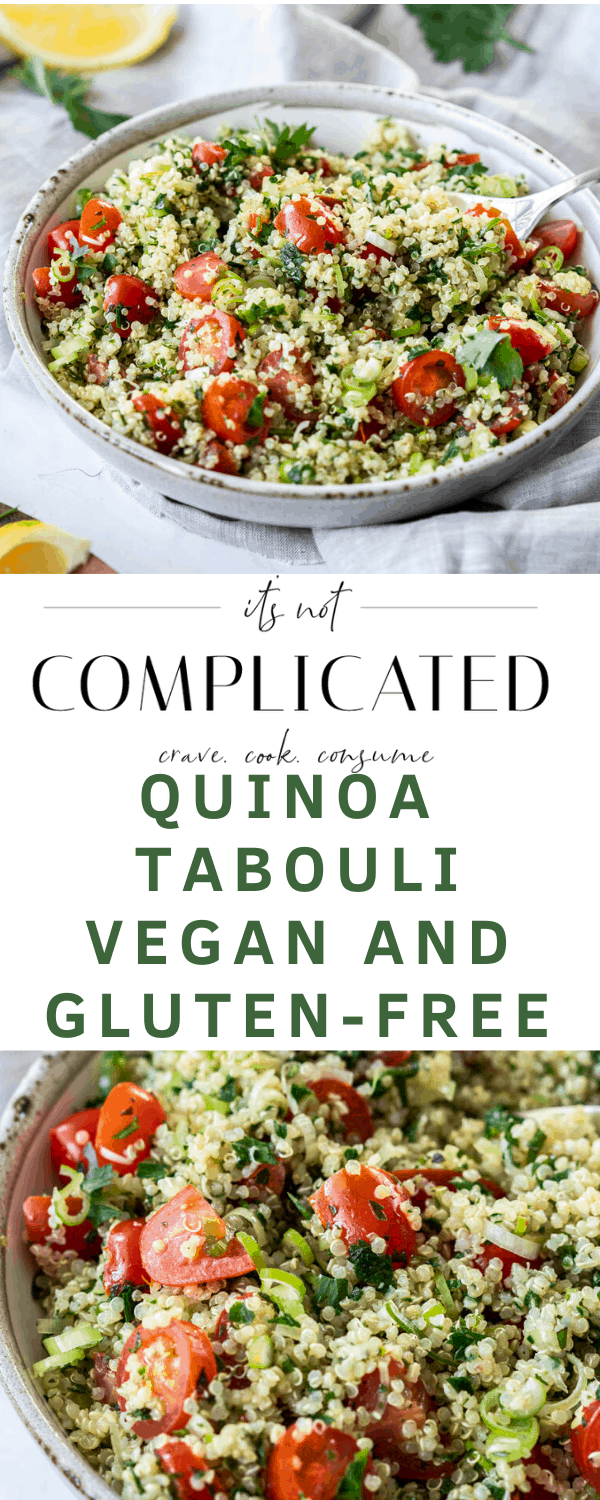

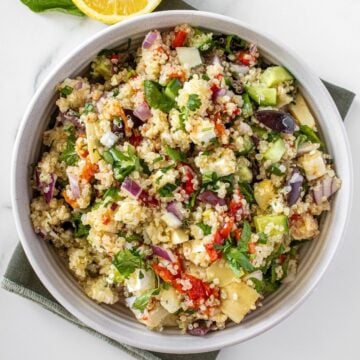
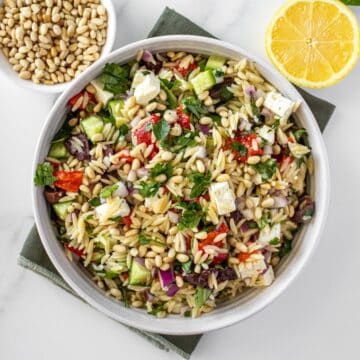
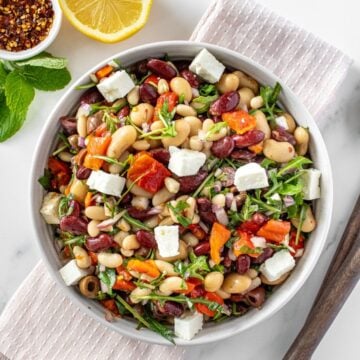
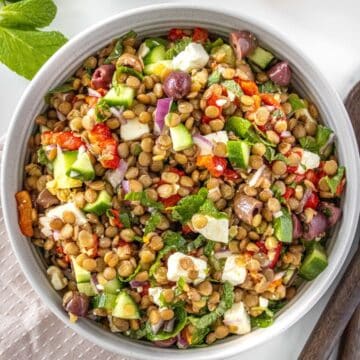
Sue says
Uncomplicated and easy to fix. I liked the addition of mint leaves. I also like that it did not have cucumber like so many other recipes. I did add a smidgen of garlic and turmeric, which made for a little bit different taste but the recipe without it was fantastic as well.
Alexandra Cook says
Thank you for trying, Sue, and also for sharing your additions 🙂
Alex xo
Velda says
I absolutely loved this recipe. I cooked my quinoa in chicken broth and I a bit more lemon juice. Thanks for sharing this 💜
Alexandra Cook says
I am so happy you enjoyed it, Velda.
Thank you for taking the time to comment, Alex xo
Leigh Hill says
I made this as a side dish a couple of weeks and it was delicious and super easy to make. Another amazing recipe 🙂
Alexandra says
Hi Leigh, I am so pleased that you enjoyed the GF Quinoa Tabouli; thank you for letting me know. 🙂
CJ says
Made this today. Taste AMAZING!!!! Thank you for sharing.
Alexandra says
Hello CJ, I am so pleased that you enjoyed the Gluten-Free Quinoa Tabouli, thank you for taking the time to let me know. 🙂
Katie says
Made this for the family and it was a hit!
Alexandra says
I am delighted to hear that your family enjoyed the tabouli, Katie. Thank you so much for letting me know. 🙂